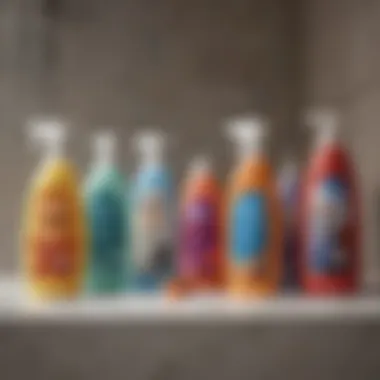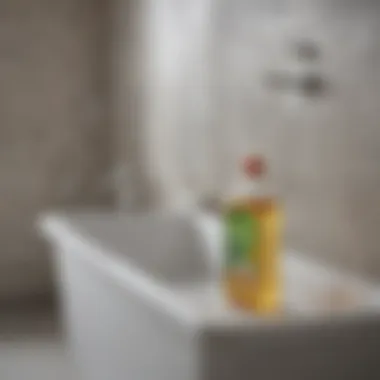Evaluating Tub and Shower Cleaner Effectiveness


Intro
Cleaning your tub and shower is often seen as a mundane task, but its importance cannot be overstated. Not only does a clean bathroom enhance the aesthetic appeal of your home, but it also contributes to hygiene and overall well-being. Grime, mildew, and soap scum are common adversaries in these spaces. Understanding how to effectively combat these issues is crucial for homeowners and housewives alike.
The home improvement industry has seen a surge in the availability of cleaning products, each claiming superior cleaning power. However, few provide in-depth information on their effectiveness, types, and environmental impact. This article endeavors to fill that gap, offering an analytical view of tub and shower cleaners, their compositions, user preferences, and their eco-friendly alternatives. The significance of this topic is heightened, considering how essential it is for homes to provide a safe and clean environment for families.
Ultimately, the aim is to equip readers with substantial knowledge, enabling informed decisions when selecting cleaning products for maintaining their bathrooms. Through this discussion, we will unravel common challenges faced by homeowners in maintaining cleanliness and provide effective solutions.
The journey of achieving and enjoying a pristine shower or tub starts with understanding the tools at one's disposal. Let's look closely at common challenges related to this task.
Understanding Tub and Shower Cleaners
Tub and shower cleaners are essential products for maintaining hygiene and aesthetics in bathrooms. Regular cleaning helps to prolong the lifespan of these fixtures and ensures a pleasant environment. Knowing how these cleaners work is vital for housewives and home owners.
Understanding the specific needs when it comes to cleaning these surfaces informs better purchasing decisions. There are numerous products available, each designed to tackle different challenges. It is critical to recognize that not all cleaners are created equally. Therefore, having solid knowledge about tub and shower cleaners can lead to more effective cleaning practices, reduced expenditure on cleaning supplies, and enhanced overall satisfaction with the home environment.
Definition and Purpose
A tub and shower cleaner is a specialized cleaning agent designed to remove dirt, soap scum, mildew, hard water stains, and other residues that accumulate over time. The primary purpose of these cleaners is to restore surfaces to their original condition. They not only enhance the visual appeal but also contribute to a more hygienic space by eliminating bacteria and preventing mold growth. The types of formulations available range from sprays and foams to biodegradable products, providing various options to suit individual preferences.
Common Stains and Build-up
Stains and build-up in tubs and showers can arise from multiple sources. The most common offenders include:
- Soap Scum: Formed when soap interacts with minerals in water, leading to a cloudy residue.
- Mildew and Mold: These fungi thrive in wet environments, making bathrooms a prime location for growth.
- Hard Water Stains: Minerals such as calcium and magnesium can leave unsightly spots on surfaces, especially in areas with hard water.
- Body Oils and Residues: These can accumulate from regular use of the shower, contributing to surface grime.
Each type of stain requires a different approach for effective removal. Understanding the nature of the build-up can lead to better strategies for choosing the correct cleaner, thus improving the overall cleaning process.
The Chemistry of Cleaners
Understanding the chemistry behind cleaning products is vital for evaluating their efficacy. Cleaners are complex formulations designed to break down stains, kill bacteria, and leave surfaces spotless. Each type of cleaner contains a specific blend of ingredients, and understanding these components can aid consumers in making informed choices. This section will delve into surfactants, the role of acids and bases in cleaners, and the growing market for biodegradable options.
Surfactants and Their Role
Surfactants, short for surface-active agents, are crucial components in most cleaning products. They work by reducing the surface tension of water, allowing it to spread and penetrate more effectively. This property helps to lift dirt and grime off surfaces.
There are several types of surfactants, including anionic, cationic, nonionic, and zwitterionic. Each type has its specific characteristics:
- Anionic surfactants are effective for a wide range of soils and create lots of foam.
- Cationic surfactants tend to have disinfectant properties and work well in fabric softeners.
- Nonionic surfactants are less sensitive to water hardness and can function effectively in both hard and soft water.
- Zwitterionic surfactants provide mildness and are great for sensitive surfaces.
The choice of surfactant can significantly affect cleaning performance. For example, if a product relies on nonionic surfactants, it may not cut through grease as efficiently compared to one that uses anionic surfactants. This understanding can help homeowners select the right products for their cleaning needs.
Acids and Bases in Cleaning Products
The pH level of a cleaner significantly influences its effectiveness against various types of stains. Acidic cleaners, typically with a pH below 7, are excellent for removing mineral deposits, rust stains, and hard water build-up. Products containing hydrochloric acid or phosphoric acid are common examples that tackle such issues in tub and shower environments. However, these powerful acids require careful handling and should be used in well-ventilated areas to minimize safety risks.
In contrast, basic cleaners, which have a pH above 7, excel at cutting through grease and organic stains. Sodium hydroxide and ammonia are frequent ingredients in these formulations. They can efficiently break down soap scum and oily residues. Awareness of these chemical properties equips consumers to choose cleaners suitable for their specific cleaning tasks.
Biodegradable Options


The movement toward sustainable cleaning products has led to the development of biodegradable cleaners. These options are formulated using naturally derived ingredients that break down more easily in the environment. The use of biodegradable surfactants helps mitigate the chemical impact of cleaning products on ecosystems.
Consumers can look for certifications such as the USDA Biobased Product Label or Green Seal to identify truly eco-friendly cleaners. As awareness of environmental issues increases, so does the availability of these sustainable options, allowing homeowners to clean confidently without compromising ecological integrity.
Types of Tub and Shower Cleaners
Understanding the various types of tub and shower cleaners is crucial for homeowners and housewives. The market offers several formulations, each designed to tackle specific cleaning challenges and preferences. Identifying the right type can significantly enhance the effectiveness of your cleaning routine and minimize the time and effort needed.
Sprays versus Foam
When considering tub and shower cleaners, one major distinction lies between spray and foam products.
Spray cleaners are favored for their ease of application. They often come in convenient bottles that allow for targeted spraying on surfaces. This feature means less wasted product and the ability to concentrate on stubborn stains. One drawback is that sprays may require a bit more scrubbing to lift tough grime, especially in corners or crevices.
On the other hand, foam cleaners deliver a thick layer that clings to surfaces. The foam adheres to vertical surfaces better, giving it time to infiltrate and break down dirt and soap scum. However, this type can sometimes be harder to control and may lead to overuse, as there is a tendency to apply more product than necessary. In summary, your choice between sprays and foams will depend on the surfaces you clean and your preferred method of application.
Natural Cleaners
Natural cleaners have gained traction among environmentally conscious consumers. These products typically use plant-based ingredients and avoid harsh chemicals, appealing to those concerned about the effects of traditional cleaners on health and the environment.
Homemade natural cleaners often utilize common household items such as vinegar, baking soda, and essential oils. Such combinations can effectively remove typical bathroom stains while promoting a healthier atmosphere in your home. However, it is important to be aware that while natural cleaners are often less abrasive, they might fall short against tough, ingrained stains compared to their chemical counterparts. As a result, while natural options are appealing for regular maintenance, they may not be suitable for heavy-duty cleaning tasks.
Commercial Versus Homemade Solutions
Choosing between commercial and homemade cleaning solutions involves various factors. Commercial products offer convenience and often boast specialized formulations promising efficiency against a wide range of stains. They save time since many are ready-to-use and require minimal preparation.
In contrast, homemade solutions allow for greater control and customization. You can adjust ingredients according to personal needs, potentially saving money in the long run. However, they do require knowledge of effective recipes and sometimes might involve more effort in preparation.
Ultimately, the decision hinges on factors like individual preferences, specific cleaning requirements, and a willingness to engage in DIY approaches. Consumers should weigh the benefits of convenience against the desire for eco-friendly, possibly cost-saving options.
"Selecting the right type of cleaner is as essential as the act of cleaning itself. Each choice reflects personal values and practical needs in maintaining a pristine bathroom."
Consumer Preferences
Understanding consumer preferences is crucial for making informed decisions about tub and shower cleaners. Different products appeal to various segments of the market based on effectiveness, ease of use, ingredients, and price. Households typically prioritize effectiveness against tough stains while balancing safety and environmental impact. This section will look closely at brands, market share, and consumer reviews, which play significant roles in shaping these preferences.
Brands and Market Share
The cleaning products market is saturated with many brands, each vying for a larger share of consumer attention. Well-known brands, such as Scrubbing Bubbles and Clorox, have established themselves through effective marketing and widely recognized product efficacy. Their presence ensures consumers often gravitate toward familiar names when choosing cleaning solutions.
Market share reflects the performance of these brands over time. Clorox, for example, leads with a sizable portion of the market due to its reputation for quality. Other players, such as Mrs. Meyer's Clean Day, appeal to those looking for eco-friendly options and natural ingredients.
Here are some common factors affecting consumer preferences for brands:
- Brand recognition
- Ingredients used
- Product effectiveness
- Pricing structure
As a result, it is essential for new entrants in the tub and shower cleaner sector to carve out unique positions, whether through sustainable practices or innovative formulations.
Consumer Reviews and Ratings
Consumer reviews serve as a reliable gauge for assessing the effectiveness of tub and shower cleaners. Online platforms allow users to share experiences, which helps inform potential buyers about product performance. Amazon, Target, and Walmart often display ratings ranging from one to five stars. Star ratings can significantly impact a product's market potential.


It is common for consumers to read multiple reviews before deciding. Positive reviews often focus on:
- Ease of use
- Stain removal ability
- Value for money
Negative reviews, conversely, typically highlight:
- Lack of effectiveness
- Harsh chemical scents
- Skin reactions
"Reviews can provide insight into actual performance beyond what marketing materials claim."
Understanding these consumer insights is reshaping the landscape of tub and shower cleaners, leading brands to focus more heavily on transparency and consumer engagement.
In summary, consumer preferences significantly influence the cleaning products market. Analyzing brand positioning and consumer feedback helps establish a clearer understanding of what drives the choices of housewives and homeowners today.
Environmental Considerations
Understanding the environmental implications of tub and shower cleaners holds considerable significance in today's cleaning product landscape. As consumers become increasingly aware of their ecological footprints, the demand for products that are both effective and environmentally friendly rises. This section delves into the impact of typical chemical cleaners and highlights sustainable options available on the market.
Impact of Chemical Cleaners
Chemical cleaners often contain a variety of substances that can pose risks to the environment. Many conventional cleaners utilize surfactants, phosphates, and harsh chemicals, which may not degrade easily. When these products are washed down the drain, they can contribute to water pollution. The long-term exposure to chemical residues can harm aquatic life, alter ecosystems, and even affect human health through contaminated water sources.
For instance, substances like bleach and ammonia can form toxic byproducts in treatment processes and lead to harmful effects on water quality. Understanding these impacts encourages consumers to evaluate their cleaning habits.
"Choosing eco-friendly products is not just a personal choice; it's a contribution towards a healthier planet."
Sustainable Products on the Market
In response to growing environmental concerns, many manufacturers now offer sustainable cleaning products designed to minimize ecological impact. These alternatives often focus on biodegradable ingredients and natural formulas. They employ plant-based surfactants and solvents which break down more easily in the environment, reducing pollution risks.
Some notable features of sustainable products include:
- Biodegradable Materials: Many eco-friendly cleaners are made from ingredients that degrade naturally.
- Minimal Packaging: Sustainable brands often emphasize reduced or recyclable packaging.
- Certifications: Look for eco-labels like Green Seal or EPA Safer Choice, which verify the product’s environmental claims.
As a result, consumers can effectively clean their tubs and showers without compromising environmental integrity. Choices made today can influence product development tomorrow, steering the market toward more sustainable practices.
Practical Cleaning Strategies
Effective cleaning strategies are essential for maintaining the longevity and appearance of tubs and showers. These strategies not only enhance the efficacy of cleaning products but also contribute to a healthier living environment. By implementing practical methods, homeowners can achieve a higher level of cleanliness while minimizing the time and effort required for upkeep. This section discusses the significance of practical cleaning approaches, emphasizing the benefits they bring and the considerations homeowners should keep in mind.
Step-by-Step Cleaning Guide
To maximize the effectiveness of tub and shower cleaners, it’s crucial to follow a structured cleaning routine. Here is a step-by-step guide:
- Preparation: Gather all necessary cleaning supplies. This includes gloves, a sponge or scrubbing brush, a bucket, and your chosen cleaner, like Mrs. Meyer's Clean Day Tub & Tile Cleaner.
- Remove Items: Clear the area of personal items such as shampoos, soaps, and loofahs. This creates a clear workspace and avoids contamination of your cleaning products.
- Rinse the Surface: Use warm water to rinse the surfaces lightly. This helps to remove surface dirt and allows the cleaner to work more effectively on any stains that remain.
- Apply Cleaner: Spray or apply your chosen cleaner generously over surfaces, focusing on problem areas like corners and grout lines.
- Allow Dwell Time: Let the cleaner sit for a specified time, usually around 5 to 10 minutes. This dwell time allows the product to break down soap scum, mildew, and other residues.
- Scrubbing: Using a sponge or a brush, scrub the surfaces methodically. For tough stains, a bit more pressure may be required, but take care to avoid damage to delicate surfaces.
- Rinse Thoroughly: After scrubbing, rinse all surfaces thoroughly with warm water to remove any cleaner residues.
- Dry Surface: Finally, dry the tub and shower surfaces with a clean towel. This step helps prevent water spots and slows down future build-up.
Remember to read the instructions on the cleaner you choose, as application and dwell times can vary by product.
Maintaining Clean Surfaces
Maintaining clean and hygienic surfaces is essential for not only visual appearance but also for health. Here are some key strategies to keep in mind:


- Regular Cleaning Schedule: Establish a routine cleaning schedule, ideally every week or bi-weekly. This prevents build-up and makes each cleaning session less time-consuming.
- Use Vinegar and Baking Soda: For maintenance cleaning, a mixture of vinegar and baking soda can be effective. They work together to tackle mild stains and odors without harsh chemicals.
- Ventilation: Ensure proper ventilation in your bathroom. Insufficient airflow can lead to mold and mildew growth. Open windows or use exhaust fans regularly to keep moisture levels down.
- Wipe Down After Use: After using your tub or shower, a quick wipe down with a squeegee can significantly reduce water marks and soap film. This simple step can help prolong the period between deeper cleanings.
- Avoid Harsh Chemicals: Regularly switching to eco-friendly cleaners can help prevent damage to surfaces while keeping them clean. Brands such as Seventh Generation offer safer alternatives that are effective yet gentle on surfaces.
By applying these practical cleaning strategies, homeowners can maintain their tubs and showers in peak conditions. Not only do these methods help preserve the appearance and functionality of the surfaces, but they also promote a cleaner and healthier home environment.
Comparative Analysis of Products
The comparative analysis of tub and shower cleaning products is essential to understand their efficacy and suitability for different cleaning needs. This section aims to dissect various options available in the market, helping readers make informed choices. It focuses on specific elements like performance, cost, environmental impact, and user satisfaction.
Conducting a comparative analysis empowers consumers to evaluate the strengths and weaknesses of various cleaning solutions. It reveals how some commercial products outperform others in removing tough stains and soap scum, while also considering the cost-effectiveness of alternatives. This aspect is particularly helpful for homeowners seeking both quality and budget-friendly options in a cleaning arsenal. Moreover, understanding the environmental implications of these products becomes a key consideration, especially given the increasing awareness around sustainability.
Top Performing Commercial Products
Among the numerous commercial options in the market, certain brands consistently receive high marks for their effectiveness. Products like Scrubbing Bubbles and Clorox have demonstrated their ability to tackle stubborn grime with less effort. Their formulations often include powerful surfactants capable of breaking down the grease and soap residue that commonly accumulate in bathrooms.
Key Features of Top Performing Products:
- Fast Acting: Many of these cleaners work within minutes, saving time during the cleaning process.
- Multi-Surface Use: They are often safe for use on various surfaces including tile, glass, and acrylic.
- Pleasant Scents: Users frequently appreciate the fresh scents that linger after cleaning.
However, potential drawbacks include higher prices and the inclusion of stronger chemicals which may raise concerns about indoor air quality. Evaluating user reviews shows that while effectiveness is a priority, many consumers are also seeking safer alternatives without sacrificing results.
Cost-Effective Alternatives
Cost-effective cleaning alternatives can serve as practical solutions for those mindful of budgets. Products such as vinegar or baking soda, commonly found in many households, prove to be both economical and efficient. These natural cleaners are versatile, allowing users to combine them for enhanced cleaning results.
Benefits of Cost-Effective Alternatives:
- Affordability: Basic ingredients like vinegar and baking soda are inexpensive and widely available.
- Non-Toxic: Many alternative solutions are less toxic than commercial counterparts, making them safer for households with children and pets.
- Eco-Friendly: These cleaners often have minimal environmental impact, aligning with the growing preference for sustainability.
Using cost-effective cleaners requires a bit of technique. For example, mixing baking soda with vinegar creates a fizzy reaction that can help lift tough stains. However, the performance may not match that of commercial products, particularly for severe build-up.
In summary, the comparative analysis of tub and shower products offers valuable insights into the most effective cleaning solutions available. Understanding both high-performing commercial options and cost-effective alternatives enables homeowners to choose based on their specific needs and values.
"Choosing the right tub and shower cleaner goes beyond labels and advertisements; it involves understanding what works best in your unique environment."
This section thus plays a critical role in guiding effective cleaning practices.
Forecasting Trends in Cleaning Solutions
In the constantly evolving market of cleaning solutions, particularly tub and shower cleaners, understanding future trends is crucial for consumers and manufacturers alike. This section will explore the emerging technologies and the increasing demand for eco-friendly products. As we dive into these trends, we will highlight their implications not only on cleaning efficacy but also on consumer behavior and environmental sustainability.
Emerging Technologies
Technology plays a pivotal role in enhancing the capabilities and efficiency of cleaning products. Various innovations are shaping the way these products are formulated and applied, leading to more effective and user-friendly cleaning solutions. Some noteworthy technologies include:
- Smart Cleaners: These products are equipped with sensors that can gauge the extent of dirt and grime buildup. They adjust the concentration of active ingredients accordingly, optimizing the cleaning process.
- Biotechnology: Utilizing microbial solutions, some brands are now developing cleaners that use natural bacteria to break down stains and odors. These biologically-inspired cleaners are particularly effective against stubborn residues.
- Nanotechnology: This involves manipulating matter on an atomic scale to enhance product performance. Cleaners developed through nanotechnology can penetrate deeper into surfaces, achieving a deeper clean without excessive scrubbing.
As cleaning technologies advance, they lead to product formulations that can clean more effectively, using fewer resources and causing less environmental impact. Consumers can thus expect future cleaning solutions that not only clean but also safeguard their health and the planet by leveraging cutting-edge innovations.
Future of Eco-Friendly Products
The demand for eco-friendly products is steadily on the rise. Consumers are becoming increasingly aware of the impact their choices have on health and the environment. Therefore, the future of tub and shower cleaners lies heavily in this trend. Several factors contribute to the growing popularity of eco-friendly cleaning products:
- Consumer Awareness: More individuals are educating themselves about the potential hazards of chemical cleaners. They prefer products that do not emit volatile organic compounds (VOCs) or contain harmful substances that affect indoor air quality.
- Regulatory Changes: Government regulations are tightening around harmful chemicals in cleaning products. Brands will need to adapt to comply with these regulations, leading to a natural shift towards safer alternatives.
- Corporate Responsibility: Many manufacturers are adopting more sustainable practices as part of their business models. This includes using biodegradable materials in packaging and sourcing natural ingredients for cleaner formulations.
The trajectory points towards a multifaceted approach that marries high performance with environmental stewardship. Eco-friendly products that work effectively will not only satisfy consumer demand but also reflect a commitment to a healthier future.
"Consumers increasingly seek products that align with their values, prioritizing sustainability alongside efficacy."







